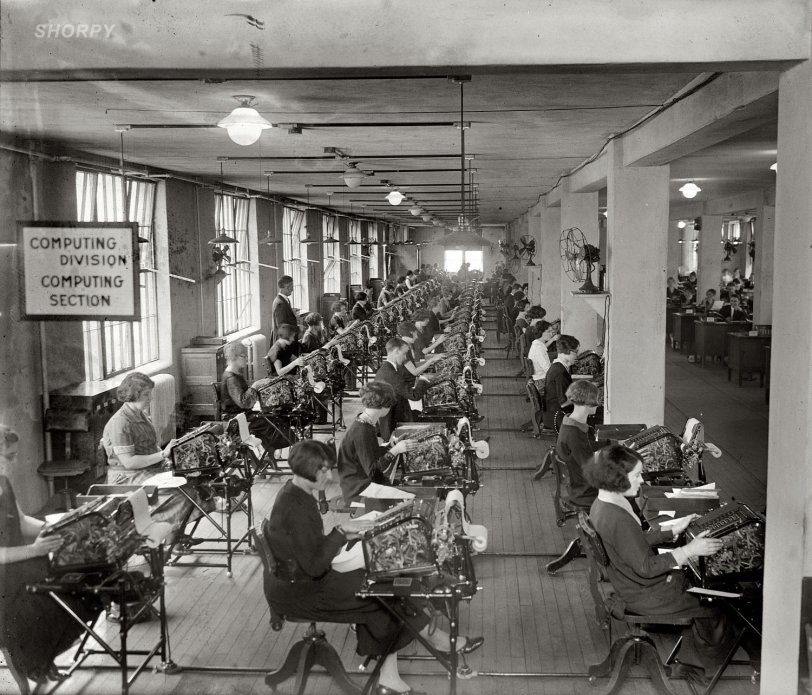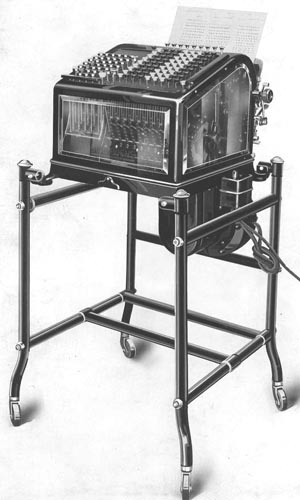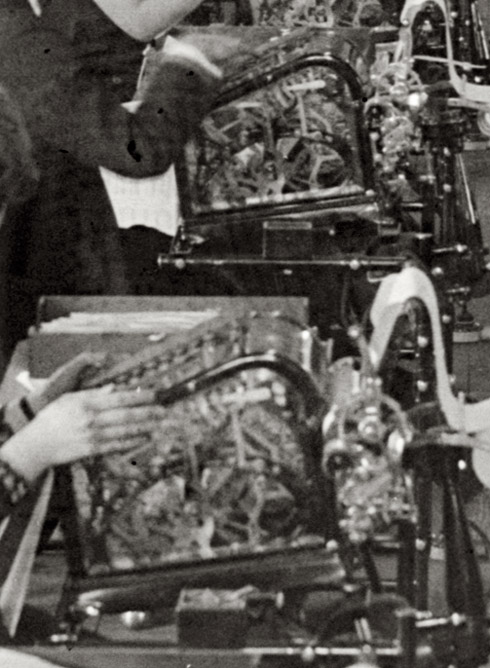


Framed or unframed, desk size to sofa size, printed by us in Arizona and Alabama since 2007. Explore now.
Shorpy is funded by you. Patreon contributors get an ad-free experience.
Learn more.

- Baldwin 62303
- Baldwin VO-1000
- Cold
- No expense spared
- Tough Guys
- Lost in Toyland
- And without gloves
- If I were a blindfolded time traveler
- Smoke Consumer Also Cooks
- Oh that stove!
- Possibly still there?
- What?!?
- $100 Reward
- Freeze Frame
- Texas Flyer wanted
- Just a Year Too Soon
- WWII -- Replacing men with women at the railroad crossing.
- Yes, Icing
- You kids drive me nuts!
- NOT An Easy Job
- I wonder
- Just add window boxes
- Icing Platform?
- Indiana Harbor Belt abides
- Freezing haze
- Corrections (for those who care)
- C&NW at Nelson
- Fallen Flags
- A dangerous job made worse
- Water Stop
Print Emporium
Multi-Processor Computing: 1924

November 24, 1924. Washington, D.C. "Bonus Bureau, Computing Division. Many clerks figure the amount of the bonus each veteran is entitled to." View full size.
Job Security
Need I remind anyone that all of these guys and dolls were employed. With the advent of modern technology many stenos, typists and other office machine operators lost their jobs. Your salary is probably even done by direct deposit to your bank. I love machines -- obviously, I'm using one now -- but they have a higher failure rate than I ever did. Have lived in interesting times.
We're so outdated....
I get depressed. I have a dual-core processor, and it's praised as "high technology". I estimate that this is at least a 60-processor system...
A long week
In response to Aching Back, My mother was working in a Massachusetts factory accounting department about 10 years after this photo. She said that a 5 and 1/2 day work week was the norm for that job in the mid-thirties.
Aching Back
While it is fun to OD on all the vintage technology in this photo, I can't help but think how miserable I would be if I had to sit there all day doing the "computing". I wonder if they had five or six day work weeks? My back aches just picturing myself getting out of the chair at the end of the work day.
System Analysis
Obviously windows users, nary an apple in sight. An arguement could be made for open source, too.
Ye Old Tyme Cube Farm
Except with lots of well-dressed young ladies. I think I prefer this!
It All Adds Up
In 1969 I had a summer job for Aetna Insurance in San Francisco (a job I hated).
In calculating insurance for plate glass I used one of these machines. They were amazingly noisy, especially when dividing when you pushed the carriage to one side, plugged in your numbers, and let it run clackety clackety for about two minutes, when it would spit out your solution.
It was just a few years later when you could buy a tiny battery run calculator.
Bonus Army
The bonus this diligent staff is calculating was for veterans of WWI. However, the money was not to be paid until 1945. With the onslaught of the hardships of the Great Depression, the veterans wanted their money sooner than later. In the spring of 1932 thousands of these veterans formed what was called a “Bonus Army” and marched on Washington demanding early payment. Congress refused and an Army contingent led by General Douglas MacArthur, and Majors Dwight Eisenhower and George Patton was ordered to forcefully remove the veterans from their encampments in the city.
See: The Bonus Army Invades Washington, D.C., 1932 at http://www.eyewitnesstohistory.com/bonusarmy.htm
Milliflops
A stunning array of milliflops of raw computing power!
This photo reminds me of the Richardson "Forecast Factory": a 1920s vision, never realized, to accomplish numerical weather prediction by assembling a grand hall of thousands of human tabulators under the direction of a central conductor.
Veterans bonus
Judging by the caption, this must have been temporary.
http://www.eyewitnesstohistory.com/snprelief4.htm
[After Congress passed the Soldiers' Bonus Act earlier in the year, the War Department hired thousands of clerks to do the calculating. - Dave]
Burroughs Accounting Tabulator
Circa 1911 Burroughs Typewriter Adding Machine. More at the Early Office Museum. And at OfficeMuseum.com. These complex devices were electromechanical, as opposed to electronic. Some used punch cards.

Tabulators
So who can tell us about these motorized mechanical tabulators? Interesting to note that the sides are glass. Easier to see what needs fixing.

Interesting technology
There are many interesting things in this photo. First of all, what caught my attention was the lighting fixtures overhead. It looks like the whole lighting circuit had been built hastily in a previously existing room; exposed metallic tubes holding the electric cables would have been embedded in the concrete slab of the roof if the installation had been designed at the same time as the building.
[If I may interject: Overhead electrical conduits in modern slab construction are generally not embedded in concrete -- the reason you can't see them is that they're obscured by a dropped ceiling. - Dave]
Another interesting thing: those tabulating machines. They are old antecedents of today's spreadsheets, and it's interesting to see that, even in this early date, those machines were already electrical. Evidently they didn't have much electronics inside - the machines must work using electromagnets and mechanical parts, but must have been able to perform basic mathematical calculations in a more precise and faster fashion than by hand. Again, the electrical circuit used to power the machines was built over an existing floor; another evidence that this room was originally intended for other use and was adapted to this task.
No air conditioning; just a few electric fans scattered here and there in the room. But there are several hot-water or steam radiators near the walls, so the building was originally equipped with central heating. Must have been a very uncomfortable place to work by the end of the day; too hot and noisy and crowded.
These pics are excellent references to how life was like before our modern world, before all the things we now take for granted were even conceived. Thanks for sharing them, this site is definitely a very valuable resource for people interested in history like me.
Back when computing clusters
needed bathroom breaks.
CPU Cooling
Wow. Even back then the processors had cooling fans.
























On Shorpy:
Today’s Top 5